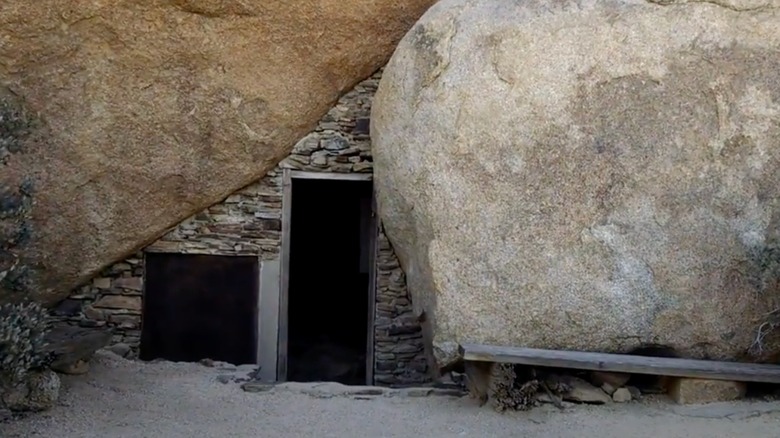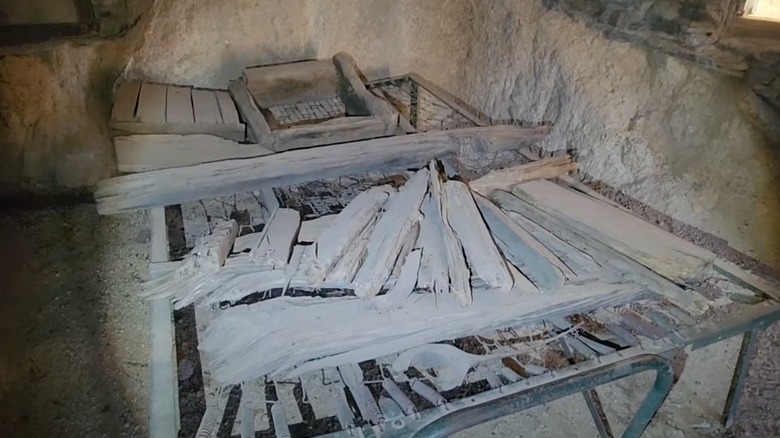Hidden Within A Scenic Joshua Tree Hiking Trail Is An Abandoned Mining Shelter Full Of Mystery And Unique Views
California is the land of big dreams, world-class surfing, and gold. Lots o' gold. It's in the name, after all: The "Golden State" doesn't actually refer to southern California's year-long sunshine but rather to the state's massive gold rush in the 19th century, which has left perfectly preserved ghost towns all over the state. Gold was first struck in Sutter's Mill in Coloma, California, in 1848, which kicked off a mass rush — a gold rush, if you will — of people from across the country flocking to the West Coast to try their luck at prospecting. No stone was left unturned in the third-largest state, including in the desert.
Located just two-and-a-half hours east of LA, Joshua Tree is known for its otherworldly boulders, possibly one of the world's best sunset viewing spots, and particular desert energy that makes it unlike anywhere else. But Joshua Tree, too, had its own place in California's mining history, as about 300 mines were dug in what's now the national park between the 1860s and 1940s. While there are a handful of abandoned mines and shelters to visit throughout the park, there's one in particular hidden off a scenic, unmarked trail that can appear like a mirage in the desert (if you can find it).
Carey's Castle is a 20th-century mining shelter built between a few of Joshua Tree's famous boulders, and it's a semi-protected secret. Carey's Castle is like "Fight Club"; the first rule is you don't talk about it, and if you go, don't put its details online. After all, reaching it is only for the most committed and those willing to tackle an 8-mile out-and-back trail across piles of boulders and sandy wash, enjoying unique views of winding canyons and towering rock formations.
A 20th-century time capsule at Carey's Castle
Part of the intrigue around Carey's Castle is the mystery behind the man who built it. Not much is known about Arthur Lloyd Cary, a prospector who'd claimed the Welcome Stranger Mine in the area. According to Modern Hiker, he had a family elsewhere and built this man-cave of sorts as his home-away-from-home close to the areas where he was trying to strike it rich, while Guy Starbuck notes that 24-year-old Cary moved to the Coachella Valley from Colorado in 1935 to prospect for gold with his father, and he lived in this shelter from 1938-1941. You can still see the entrance to his mine, a few hundred feet away, and artifacts left behind confirm that Cary built and lived here in the late 1930s or early 1940s.
Although the wooden door that marked the shelter may have been removed in recent years, certain elements have stayed in place in this home that Cary built in the hollow space between Joshua Tree's moon-like boulders. Although for years, this well-kept secret location was protected by the hiker's code of protecting a sacred place, recently, people have removed objects from it to keep for themselves. There are still some artifacts, like rusted equipment, parts of an old chimney, and an ammo can with a guest book for visitors to sign. Pictographs on the ceiling indicate that indigenous folks also used this shelter in the years before the Europeans' arrival. So, despite the looting, this place has retained its alluring aura of mystery and history, as it's hard not to imagine what life was like for Cary and all those who came before.
Tips for visiting Carey's Castle
While it's possible to find more detailed information online about getting to Carey's Castle, this unmarked trek is not one for inexperienced hikers to do alone, particularly if it's your first solo hike that you want to do safely. It's recommended to either go with someone who knows and, at the very least, bring a topographic map and a compass, particularly as cell and GPS service may be spotty in the desert (be sure to download maps). There are no water sources along the way, so some suggest bringing at least a gallon per person – more if you're planning to camp. The trail to Carey's Castle begins near the Chiriaco Summit exit off the I-10, near the park's southeast boundary, and you may have to drive past a "No Trespassing" sign to get there, although you may incur a fine for doing so (many haven't).
In recent years, Joshua Tree National Park has been the site of increasing incidents of vandalism, with street artists like Mr. Andre and others tagging boulders with paint and graffiti. Others have looted places like Carey's Castle and taken its historic objects as souvenirs, which led to its closure in 2016 and at the end of 2024. It's unknown at this time if the site has reopened, so it's best to check with a park ranger. Trump has proposed massive (and controversial) budget cuts to national parks, which will make it even harder to protect unique sites like Carey's Castle, as there will be limited resources. That makes it extra imperative to practice "leave no trace" when visiting the site and to only take photos of objects.


